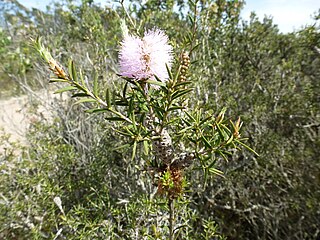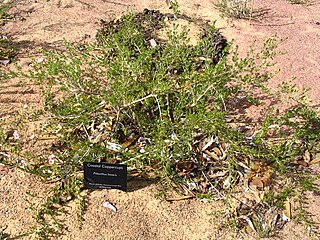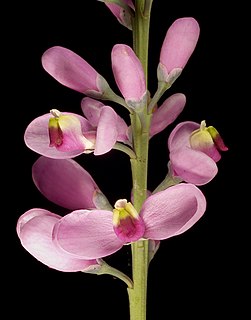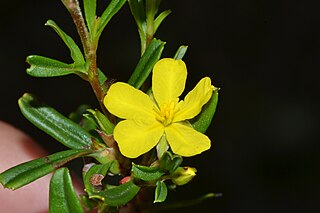
Spyridium globulosum, commonly known as basket bush, is a species of flowering plant in the family Rhamnaceae and is endemic to coastal areas in the south-west of Western Australia. It is a shrub with relatively large leaves and heads of flowers covered with whitish hairs.

Melaleuca cuticularis, commonly known as the saltwater paperbark is a tree in the myrtle family, Myrtaceae and is native to the south-west of Western Australia. There is also a disjunct population on Kangaroo Island in South Australia. It is distinguished from other melaleucas by its unusual fruits and very white, papery bark.
Gahnia trifida, the coastal saw-sedge, is a tussock-forming perennial in the family Cyperaceae, endemic to southern Australia.

Olearia ramulosa, commonly known as twiggy daisy-bush, is a species of flowering plant in the family Asteraceae and is endemic to south-eastern Australia. It is a shrub with narrowly elliptic, linear or narrowly egg-shaped leaves, and pale blue, mauve or white and yellow, daisy-like inflorescences.

Calothamnus sanguineus, commonly known as silky-leaved blood flower, is a plant in the myrtle family, Myrtaceae and is endemic to the south-west of Western Australia. The Noongar peoples know the plant as Boolgalla. It is an erect to spreading shrub with short, cylindrical leaves and red or white flowers with an unusual arrangement of stamens, often flowering in autumn, winter or spring. It was the first of its genus to be formally described.

Anthocercis littorea, also known as yellow tailflower, is a species of shrub in the family Solanaceae. It's native to Western Australia where it grows on coastal limestone and dunes as well as sandplains.

Olearia myrsinoides, commonly known as silky daisy-bush or blush daisy bush, is a species of flowering plant in the family Asteraceae and is endemic to south-eastern Australia. It is a spreading shrub with hairy branchlets, egg-shaped to elliptic leaves with toothed edges, and white and yellow or mauve, daisy-like inflorescences.

Melaleuca pentagona is a plant in the myrtle family Myrtaceae and is endemic to the south of Western Australia. It is a showy, medium-sized shrub which produces large numbers of pink flowers in spring. There are three varieties recognised, one of which has been known in cultivation for many years.

Melaleuca striata is a plant in the myrtle family, Myrtaceae, and is endemic to the south of Western Australia. It has distinctive leaves and heads of pink to mauve flowers, usually in late summer.

Melaleuca thymoides is a plant in the myrtle family, Myrtaceae, and is endemic to the south-west of Western Australia. It is usually a low shrub. The ends of the branches usually end in a sharp spine and the leaves also have a sharp point. Bright yellow flowers appear on the ends of the branches in spring or early summer.

Pileanthus limacis, commonly known as coastal coppercups, is a plant species of the family Myrtaceae endemic to Western Australia.

Comesperma virgatum, commonly known as milkwort, is a herb in the family Polygalaceae. It is an erect slender herb growing to between 30 cm and 1.6 m high, on sandy and lateritic soils, and sometimes in swampy conditions. Its pink to purple flowers may be seen from September to December or January to March.

Hibbertia acicularis, commonly known as prickly guinea-flower, is a species of flowering plant in the family Dilleniaceae and is endemic to eastern Australia. It is an erect or prostrate shrub with linear to lance-shaped leaves and yellow flowers arranged singly in leaf axils with the six to eight stamens joined at the base, in a single cluster.

Hibbertia procumbens, commonly known as spreading guinea flower, is a species of flowering plant in the family Dilleniaceae and is endemic to south-eastern Australia. It is a prostrate, often mat-forming shrub with more or less glabrous stems, linear to narrow lance-shaped leaves with the narrower end towards the base, and yellow flowers with eighteen to twenty-five stamens arranged in groups around usually four glabrous carpels.

Gompholobium tomentosum, commonly known as hairy yellow pea, is a species of flowering plant in the pea family Fabaceae and is endemic to the south-west of Western Australia. It is an erect shrub with hairy foliage, pinnate leaves with five to seven leaflets, and uniformly yellow, pea-like flowers.

Hibbertia racemosa, commonly known as stalked guinea flower, is a species of flowering plant in the family Dilleniaceae and is endemic to the south-west of Western Australia. It is an erect or ascending, spreading shrub that typically grows to a height of 10–75 cm (3.9–29.5 in) and produces yellow flowers between July and December.

Leucopogon collinus, commonly known as fringed beard-heath, is a species of flowering plant in the heath family Ericaceae and is endemic to south-eastern Australia. It is a slender, erect or spreading shrub with narrowly lance-shaped leaves, and white, tube-shaped, bearded flowers.

Epacris heteronema is a species of flowering plant in the heath family Ericaceae and is endemic to Tasmania. It is an erect shrub with many branches, that typically grows to a height of 0.6–6 m. Its leaves are egg-shaped with an often heart-shaped base and a sharply-pointed tip. The flowers are arranged singly in a few leaf axils near the ends of the branches and are white and tube-shaped, with lobes about the same length as the petal tube.

Olearia stellulata is a species of flowering plant in the family Asteraceae and is endemic to south-eastern Australia. It is a shrub with lance-shaped or narrowly elliptic leaves, and white and yellow or mauve, daisy-like inflorescences.
Pimelea clavata is a species of flowering plant in the family Thymelaeaceae and is endemic to near-coastal areas and offshore islands of southern Western Australia. It is an erect shrub with narrowly elliptic to more or less linear leaves arranged in opposite pairs, and head-like clusters of white to pale yellow, tube-shaped flowers surrounded by leaf-like involucral bracts.



















